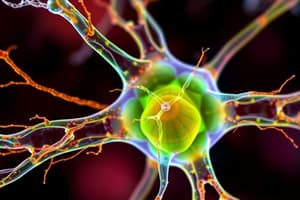Podcast
Questions and Answers
What role do microtubules play during cell division?
What role do microtubules play during cell division?
- They assist in the formation of the nuclear envelope.
- They create structural integrity by forming the cell membrane.
- They transport nutrients throughout the cytoplasm.
- They help separate chromosomes. (correct)
Which protein interacts with actin filaments to facilitate cell movement?
Which protein interacts with actin filaments to facilitate cell movement?
- Kinesin
- Tubulin
- Myosin (correct)
- Dynein
How do eukaryotic flagella differ from bacterial flagella in structure?
How do eukaryotic flagella differ from bacterial flagella in structure?
- Eukaryotic flagella rotate continuously like a propeller.
- Eukaryotic flagella contract like muscle cells.
- Eukaryotic flagella are made of microtubules. (correct)
- Eukaryotic flagella are made of protein filaments called flagellin.
What is the primary component that forms actin filaments?
What is the primary component that forms actin filaments?
What distinguishes cilia from flagella in terms of cellular structure?
What distinguishes cilia from flagella in terms of cellular structure?
What role do dynein arms play in the movement of cilia and flagella?
What role do dynein arms play in the movement of cilia and flagella?
What is the key structure that powers the movement of cilia and flagella?
What is the key structure that powers the movement of cilia and flagella?
Which components form the basic structural unit of the axoneme?
Which components form the basic structural unit of the axoneme?
How does the addition of ATP affect dynein activity?
How does the addition of ATP affect dynein activity?
What is the arrangement of microtubules in the axoneme?
What is the arrangement of microtubules in the axoneme?
What is the primary function of phagocytosis in a cell?
What is the primary function of phagocytosis in a cell?
Which component of the cytoskeleton is primarily responsible for providing structural support?
Which component of the cytoskeleton is primarily responsible for providing structural support?
What characterizes microtubules in terms of their structure?
What characterizes microtubules in terms of their structure?
In which process does a damaged organelle become enclosed within a membrane to be digested?
In which process does a damaged organelle become enclosed within a membrane to be digested?
How do actin filaments contribute to the cell's plasma membrane?
How do actin filaments contribute to the cell's plasma membrane?
What roles do microtubules serve within the cell?
What roles do microtubules serve within the cell?
Which structure serves as the organizing center for microtubules in animal cells?
Which structure serves as the organizing center for microtubules in animal cells?
What initiates the formation of a phagosome during phagocytosis?
What initiates the formation of a phagosome during phagocytosis?
Flashcards are hidden until you start studying
Study Notes
Microtubules
- Microtubules are hollow tubes made of tubulin.
- Microtubules can act as “highways”, transporting vesicles via the protein kinesin.
- Microtubules are involved in separating chromosomes during cell division.
- Microtubules originate from the microtubule organizing center, such as the centrosome in animal cells.
- Microtubules are directional - they have a “-” end and a “+” end.
Actin filaments
- Actin filaments are the smallest cytoskeletal elements, formed by polymerization of actin proteins.
- Actin filaments are directional - they have a “-” end and a “+” end.
- Actin filaments are arranged in bundles that are typically found near the plasma membrane, helping to define the cell’s shape.
- Actin filaments interact with the protein myosin, resulting in movements such as cell crawling, cytokinesis, and cytoplasmic streaming.
- Actin is essential for muscle tissue contraction.
Moving Whole Cells: Cilia & Flagella
- Flagella and cilia are hair-like projections from the cell that allow the cell to move.
- Flagella are long and move like a propeller, while cilia are shorter and wave back and forth.
- Bacterial flagella are composed of flagellin, while eukaryotic flagella are composed of microtubules.
- Cilia are involved in moving substances like mucus and nutrients in the airways and digestive tracts.
- Cells usually have one or two flagella, but may have many cilia.
Receptor-mediated endocytosis
- This process uses receptors to bind to macromolecules outside the cell.
- The plasma membrane pinches inwards, forming a vesicle that delivers cargo to the lysosome.
- Recycling of receptors allows for continuous uptake of molecules.
Phagocytosis
- This is a process that engulfs smaller cells or food particles into the cell, forming a phagosome.
- The phagosome is then delivered to the lysosome for digestion.
Autophagy
- This process encloses damaged organelles within a membrane to form an autophagosome.
- The autophagosome is then delivered to the lysosome for digestion.
The Cytoskeleton: Moving down the roads
- The cytoskeleton is a network of protein fibers that give the cell shape, organizational stability, and facilitates movement.
- The cytoskeleton helps to organize organelles and cellular structures.
- The three main components of the cytoskeleton are: Microtubules, Intermediate Filaments, and Actin filaments.
- Microtubules act as the "interstates" of the cell, providing a pathway for molecule delivery.
- Intermediate filaments provide structural support.
- Actin filaments help to shape the plasma membrane.
Cytoskeletal Structures
- Microtubules are made of tubulin.
- Actin filaments are made of actin.
- Intermediate filaments are made of various proteins.
Axoneme: A complex machine
- The axoneme is a complex structure that powers the movement of cilia and flagella.
- It is composed of microtubule doublets and central microtubules.
- Dynein arms, located on the microtubule doublets, “walk” along the microtubules, causing the axoneme to bend.
- ATP is required for dynein to “walk” along the microtubules.
Studying That Suits You
Use AI to generate personalized quizzes and flashcards to suit your learning preferences.




